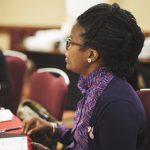Reflections of a (White) Feminist
wo years ago, I moved from Alaska to Washington DC to work for Alteristic and I was excited for both the professional and personal journeys I would go on. Personally, I was excited to immerse myself in a new community and find outlets for my need to be an activist around social justice issues I believe in. Washington DC is alive with activism. People of all walks of life, representing political views all along the spectrum can find a seemingly endless number of marches, rallies, protests, vigils and on and on to participate in. I jumped in feet first, attending as many as possible, trying to find a sense of community and belonging with other folks dedicated to bettering our world. Attending these events left me feeling strengthened and empowered – standing shoulder to shoulder with so many women and men from different walks of life, moving toward a singular goal was truly inspiring. I rode the wave of that strength and excitement until a good friend mentioned why she often declined invitations to join me.
She explained that as a woman of color, she doesn’t often see herself represented in the planning efforts or in the promotional materials for the events I was attending. Smiling pictures of white women with linked arms on flyers hadn’t made her feel included or welcome. I did some research and learned that many of the events I had attended didn’t have good representation of women of color in planning efforts or leadership. Some had women of color as speakers but not in leadership roles, possibly serving to tokenize them instead of meaningfully engage them. My research uncovered that many of the same feelings and hesitations experienced by my friend are also experienced by transgender women. What if they don’t see themselves represented in planning efforts or promotional materials? Were they still included? Needed, even?
As I began to dig deeper into these issues and into myself, I came across a concept called white feminism. White feminism is a brand of feminism centered around the ideals and struggles of primarily white women. While not outright exclusive, its failure to consider other women and its preoccupation with Western standards and the problems faced by the “average woman” is often alienating to women of color, non-straight women, transgender women, and women belonging to religious or cultural minorities. [1]
I’m not a feminist because I want white women to have equal footing in society. I’m a feminist because I believe that all women should be valued and treated as equals to men. I believe women should be safe, should be able to earn a fair wage for their work, should be afforded freedom and a full range of human rights. I’m a feminist because I believe we should dismantle systems that oppress women instead of finding ways to survive within them. And yet, during a time of grappling with my place as an activist in a new community, I selected events with no thought about who might feel left out or left behind. When I realized that, I felt bad, but a voice in my head emerged quickly to assure me, “you didn’t intend to leave anyone out, give yourself a break.” A hard thing for me to recognize has been that even when your intentions are truly good, they are totally meaningless. What matters is your impact, not your intentions, and you don’t get credit for thinking good thoughts.
If the impact of me posting my smiling pictures of activism was that women of color or trans women who are my friends felt like my brand of feminism didn’t include them, then the impact was harmful and I need to do better. As I work to ensure I’m not a white feminist, but am truly an intersectional feminist, I’ll need to spend a lot more time listening than speaking. Listening to women of color, listening to women who experience forms of oppression that I am safe from so I can then take their lead to ensure their realities are centered in my advocacy efforts. How can I use my platform to amplify their voices without speaking for them? How can I best stand as an ally?
Even as I challenge myself within my personal activism, I think as the field of prevention, we must work harder to bring intersectionality to the forefront of our efforts. One of the core values of our prevention work is the value of including everyone and excluding no one. We need a critical mass of people involved in prevention in order to tackle huge societal issues such as domestic and sexual violence. We can’t afford to alienate anyone with our efforts or to leave anyone behind. Our intentions as a field are good, we must do the hard work of ensuring our actions and impacts are in line with them. Professionally, I intend to carry forward some of the lessons I have learned personally this year. I will listen more than I talk and seek out the wisdom and leadership of people of color and members of the LGBTQ community as I shape my prevention efforts. And I will continue to ask questions – of myself personally and of my field.
I know answers to my questions might not come easily, but I’m thankful to be at a place to know to ask them. As I prepare for my next round of activist events, I’ll be listening closely for the voices of women of color in the crowd so I can amplify their chants instead of drowning them out with my own.
[1] https://www.urbandictionary.com/define.php?term=white%20feminism






